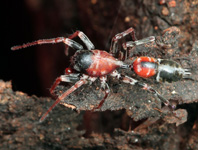Abstract
The rare ant mimicking sac spider genus Aetius was erected by O. Pickard-Cambridge in 1896 based on an unspecified number of female specimen(s) collected from Sri Lanka. The type species of the genus, A. decollatus O. Pickard-Cambridge, 1896, has been redescribed twice based on the holotype (Majumder & Tikader 1991; Deeleman-Reinhold 2001). Reimoser (1934) recorded the genus for the first time from India, who collected a male specimen from Mudumalai Tiger Reserve in Tamil Nadu State of southern India. This specimen was identified as A. decollatus, but it was never formally described and was later recognised to be a penultimate male (Dankittipakul & Singtripop 2013). Deeleman-Reinhold (2001) described the second representative of the genus, A. nocturnus, based on a single female specimen from Borneo, 105 years after the establishment of the genus. Dankittipakul & Singtripop (2013) described the male of A. nocturnus, thereby revealing the male genitalia of the genus, but the type species was still known only from the female sex.
References
Bosselaers, J. & Jocqué, R. (2000) Studies in Corinnidae: transfer of four genera and description of the female of Lessertina mutica Lawrence 1942. Tropical Zoology, 13, 305–325.
http://dx.doi.org/10.1080/03946975.2000.10531138Dankittipakul, P. & Singtripop, T. (2013) First description of the male of the little-known ant mimicking spider genus Aetius O. Pickard-Cambridge (Araneae: Corinnidae). Revue Suisse de Zoologie, 120, 575–583.
Deeleman-Reinhold, C.L. (2001) Forest spiders of South East Asia: with a revision of the sac and ground spiders (Araneae: Clubionidae, Corinnidae, Liocranidae, Gnaphosidae, Prodidomidae and Trochanteriidae). Brill, Leiden, 591 pp.
Herberstein, M.E., Wignall, A.E., Nessler, S.H., Harmer, A.M.T. & Schneider, J.M. (2012) How effective and persistent are fragments of male genitalia as mating plugs? Behavioral Ecology, 23, 1140–1145.
http://dx.doi.org/10.1093/beheco/ars088Majumder, S.C. & Tikader, B.K. (1991) Studies on some spiders of the family Clubionidae from India. Records of the Zoological Survey of India, Occasional Paper, 102, 1–175.
Murthappa, P.S., Prajapati, D.A., Sankaran, P.M. & Sebastian, P.A. (2016) First records of the genus Cambalida Simon, 1909 (Araneae: Corinnidae, Castianeirinae) from Asia, with the description of two new species from India and one new combination. Zootaxa, 4103 (6), 526–536.
http://dx.doi.org/10.11646/zootaxa.4103.6.3Marusik, Y.M., Omelko, M.M. & Koponen, S. (2015) A redescription of the ant mimicking spider Myrmecium gounellei (Araneae: Corinnidae, Castianeirinae), with notes on the genus. Zootaxa, 3985 (2), 296–300.
http://dx.doi.org/10.11646/zootaxa.3985.2.9Pickard-Cambridge, O. (1896) On some new and little known spiders (Araneidae). Proceedings of the Zoological Society of London, 1896, 1006–1012.
Petrunkevitch, A. (1928) Systema Aranearum. Transactions of the Connecticut Academy of Arts and Sciences, 29, 1–270.
Raven, R.J. (2015) A revision of ant-mimicking spiders of the family Corinnidae (Araneae) in the Western Pacific. Zootaxa, 3958 (1), 1–258.
http://dx.doi.org/10.11646/zootaxa.3958.1.1Reimoser, E. (1934) Araneae aus Süd-Indien. Revue Suisse de Zoologie, 41, 465–511.
http://dx.doi.org/10.5962/bhl.part.155628Reiskind, J. (1969) The spider subfamily Castianeirinae of North and Central America (Araneae, Clubionidae). Bulletin of the Museum of Comparative Zoology, 138, 163–325.
Uhl, G., Nessler, S.H. & Schneider, J.M. (2010) Securing paternity in spiders? A review on occurrence and effects of mating plugs and male genital mutilation. Genetica, 138, 75–104.
http://dx.doi.org/10.1007/s10709-009-9388-5

